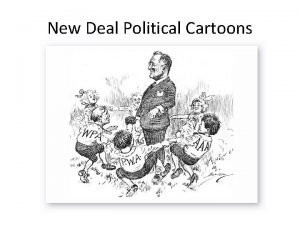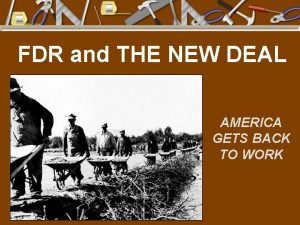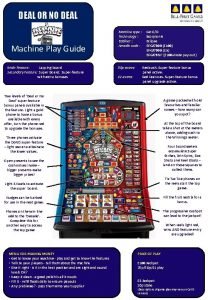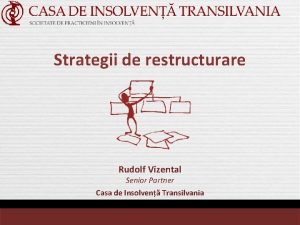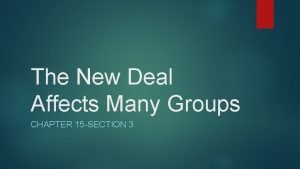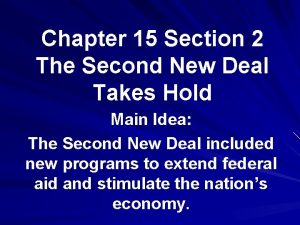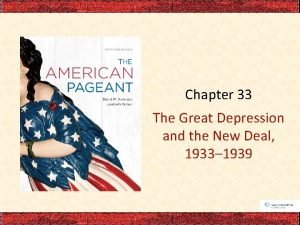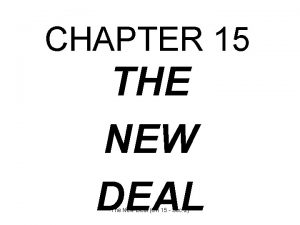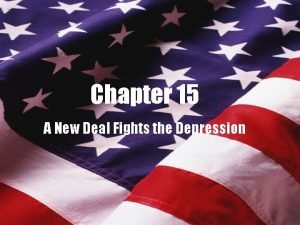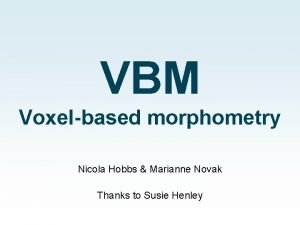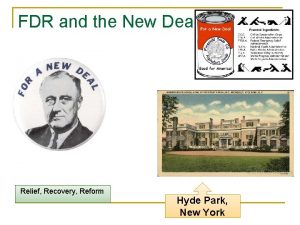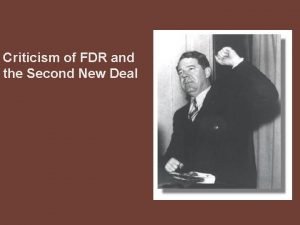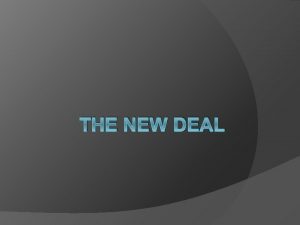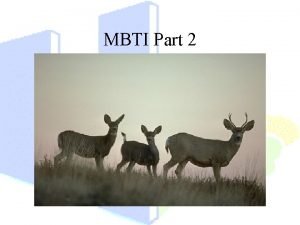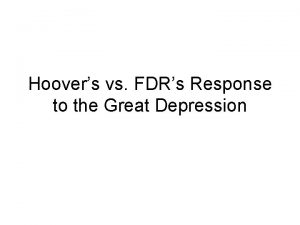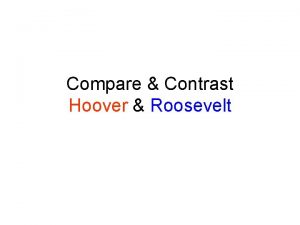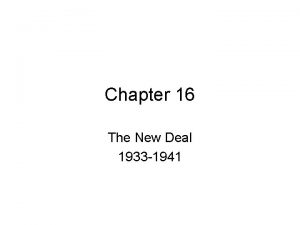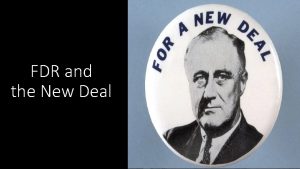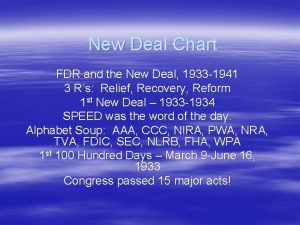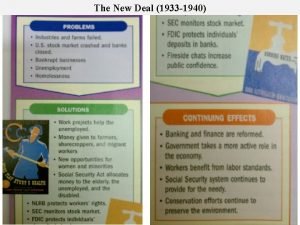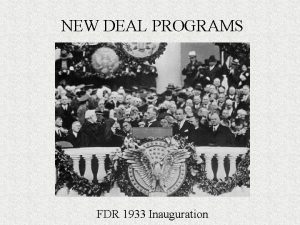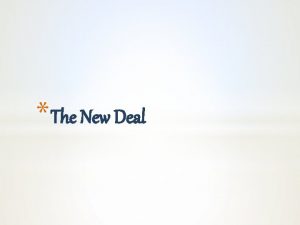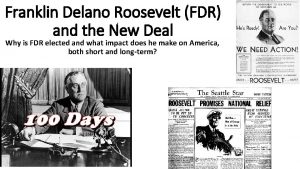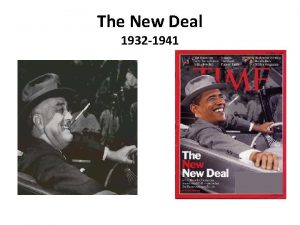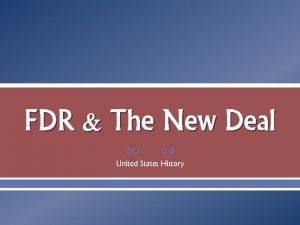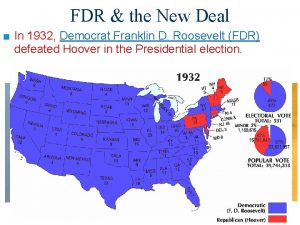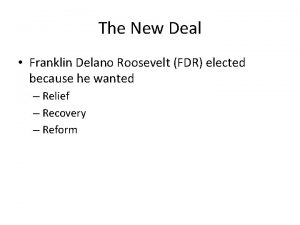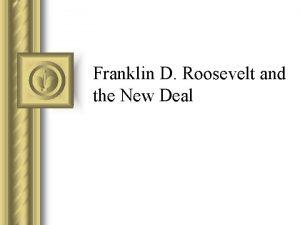Chapter 22 The New Deal FDR 1933 Franklin
















- Slides: 16

Chapter 22 The New Deal

FDR Ø 1933: Franklin D. Roosevelt takes office Ø Pledged the “New Deal” Ø Bipartisan: took in Republicans and women on his Cabinet

Eleanor Roosevelt Ø FDR’s wife, very outspoken 1 st lady. Ø Became the “eyes and ears” on the United States

First 100 Days Ø Emergency Banking Bill: banks closed for 4 days to get accounts in order Ø Fireside Chats: radio speeches to the people to deliver hope

Government Programs Ø Federal Deposit Insurance Corporation (FDIC): insured banks up to $5, 000 Ø Securities and Exchange Commission (SEC): regulate stock market

New Deal Programs Ø Farmers: Agricultural Adjustment Act l End overproduction and raise crop prices Ø Tennessee Valley Authority: built dams to control floods and generate power Ø Civilian Conservation Corps: gave 2 million young men jobs

New Deal Cont… Ø Ø National Recovery Administration: developed codes of fair competition l Established minimum wage and minimum good prices Public Works Administration: built bridges, dams, power plants, and government buildings

Opposition to FDR Huey Long - Senator from Louisiana, who opposed Roosevelt. Was considered a serious threat to become the next president, but was assassinated by a lone gunman. “Every Man A King” Ø Republicans said “too much” Ø l Ø Government was too powerful Socialists said “not enough”

Second New Deal Ø Addressed social problems l Elderly, poor, unemployed, workers, and farmers

Works Progress Administration Ø Created to distribute $5 billion for new jobs Ø Employed 8 million people Ø Built 650, 000 miles of highway Ø 125, 000 buildings Deficit Spending spending more money than the government receives in revenue.

Social Security Ø Old-age insurance for retirees 65 or older and their spouses Ø Unemployment Compensation Ø Aid to families with dependent children and the disabled

Farmers Rural Electrification Administration: loaned money to build power lines and bring electricity to rural areas Ø Water Projects: irrigation and dams Ø

Labor Rights Wagner Act – recognized the right of employees to join labor unions and gave workers the right to Collective Bargaining. Ø Fair Labor Standards Act l Banned child labor l Created minimum wage l 44 hour work week Ø Congress of Industrial Organizations (CIO) l labor unions l Ethnically more diverse Ø

Effects of the New Deal Millions employed through programs Ø Banking system is stabilized Ø Stock market regulations Ø Social insurance for elderly and poor Ø Farming help Ø Government takes more active role in economy Ø Women and African Americans make advances Ø

Culture of the 1930’s Movies and Radio Ø Swing Music Ø Murals Ø Ø Literature l Grapes of Wrath

Golden Age of Hollywood
 Political cartoons fdr
Political cartoons fdr Nlra poster
Nlra poster Deal or no deal machine
Deal or no deal machine Asset deal vs share deal
Asset deal vs share deal The new deal affects many groups chapter 15 section 3
The new deal affects many groups chapter 15 section 3 The second new deal takes hold chapter 15 section 2
The second new deal takes hold chapter 15 section 2 Chapter 33 the great depression and the new deal
Chapter 33 the great depression and the new deal Tennessee valley basin
Tennessee valley basin Chapter 15 section 1 a new deal fights the depression
Chapter 15 section 1 a new deal fights the depression Vbm cross
Vbm cross Fdr
Fdr Examples of relief recovery and reform
Examples of relief recovery and reform Criticism of fdr
Criticism of fdr Fdr
Fdr Grille mbti
Grille mbti Hoover v. fdr: responses to the great depression
Hoover v. fdr: responses to the great depression Herbert hoover and franklin roosevelt compare and contrast
Herbert hoover and franklin roosevelt compare and contrast
